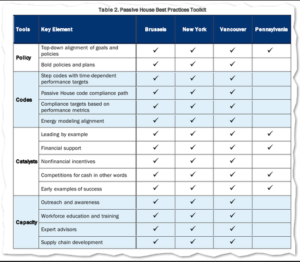This in-depth international review, The Keys to Successful Passive House Implementation, aimed to identify how to successfully implement Passive House construction at scale. The research was commissioned by the California Public Utilities Commission, which aims to apply these learnings in that state.
The report developed a “Passive House Best Practices Toolkit” to increase the uptake of the Passive House standard and leverage the benefits. It identified four main tools (report text in italics, followed by my summary/comments).
- Policy establishes the framework for planning strategies and designing codes to ensure accomplishment of the goal.
Enact bold, top-down aligned policies with an end goal of reducing greenhouse gas emissions. Use carrots and sticks to encourage compliance.
2. Codes support policy by establishing minimum standards, metrics, and methods for measuring compliance.
Pass building codes that set standards and how demonstrate how compliance is measured. Use step changes—steady incremental change on defined timelines—that lay out a clear path for industry. Set energy modelling and compliance targets based on holistic performance metrics. Establish Passive House certification code compliance path
3. Catalysts stimulate market action through financial means or via other incentives.
Catalyse the market with incentives, example projects, financial support and even have them compete for incentives (Pennsylvania did this to an incredible extent, as I discussed here).
4. Capacity building strives to ensure the availability of people and resources necessary for the accomplishment of the goal.
Build capacity in the industry by providing workforce education and training, awareness and outreach to industry (and the public) and provide funded expert advisors. Perhaps most importantly, work on supply chain development.

Graphic: The Keys to Successful Passive House Implementation
The report made the following observations about the four regions they took as case studies.
“Brussels, Belgium catapulted from among Europe’s worst to first in terms of building energy use by using a well-considered and well-funded Passive House design and construction competition.
New York State and New York City provide a powerful example of how state and local efforts work in tandem to achieve individual and shared climate action goals through effective alignment of policies and implementation efforts, including promoting PH design strategies to significantly reduce building energy use and carbon emissions from existing buildings.
Vancouver, Canada having studied the early successes of Brussels and New York, demonstrates the execution of a comprehensive climate action strategy employing PH design strategies to minimise energy use and maximise GHG reductions from new construction.
While Pennsylvania’s statewide approach may be less comprehensive than the other examples cited here, their innovative idea of combining PH certification requirements into the state’s competitive Low Income Housing Tax Credits scoring process has been emulated in dozens of states across the nation.”
Incidentally, this passage neatly expresses my own wonder and love for Passive House …
“Imagine buildings so well constructed they need virtually no heating or cooling, and can cut normal utility bills by 50-80%. Now, imagine these buildings are also so airtight there is almost no air leakage or outside street noise, yet they provide health, fresh, filtered air throughout the day whether windows or doors are open or not.
“Moreover, these buildings are not dark boxes with tiny windows, but light, bright, spacious structures with modern architectural design. Further, when paired with high efficiency all electric appliances and onsite photovoltaics, these buildings can be virtually zero carbon emissions.
“And last but not least, they can be new construction or retrofit and are adaptable to historic, traditional, and contemporary aesthetics as well.”